| Article ID | Journal | Published Year | Pages | File Type |
|---|---|---|---|---|
| 1998730 | Molecular Genetics and Metabolism | 2013 | 7 Pages |
BackgroundEmerging evidence has revealed a close relationship between obesity and osteoporosis. It was reported recently that conditional knockout of the Spry1 gene in mice adipocytes causes an increase in body fat and a decrease in bone mass, and that these phenotypes are rescued by Spry1 overexpression in adipose tissue. In this study, we investigated whether genetic variation in the human SPRY1 gene is associated with obesity-related phenotypes and/or osteoporosis in humans.MethodsWe performed a candidate gene association analysis between the four single nucleotide polymorphisms (SNPs) and 14 imputed SNPs in the SPRY1 gene and obesity-related traits and osteoporosis in a Korean women cohort (3013 subjects).ResultsAll four SPRY1 gene SNPs were significantly associated with either obesity-related traits or osteoporosis. The TGCC haplotype in the SRPY1 gene showed simultaneous association with an increased risk for obesity-related traits, percentage body fat (p = 0.0087) and percentage abdominal fat (p = 0.047), and osteoporosis (odds ratio = 1.50; p = 0.025) in the recessive genetic model.ConclusionsOur results support a previous finding in conditional Spry1 gene knockout mice and suggest that the SPRY1 gene is an important genetic factor for determining the risk of both obesity and osteoporosis in humans.
► Sprouty1 has been suggested as a key regulator of both osteogenesis and adipogenesis of MSCs in mice. ► SPRY1 SNPs were associated with obesity-related traits and osteoporosis in Korean women. ► The SRPY1 TGCC haplotype homozygote showed a simultaneous association with obesity and osteoporosis. ► The SPRY1 gene may be a novel susceptibility gene for obesity and osteoporosis in humans.
